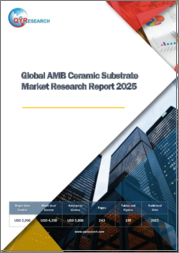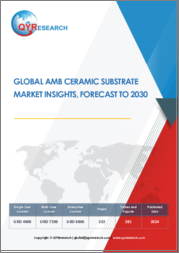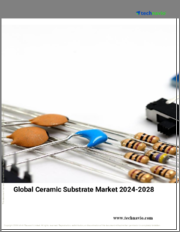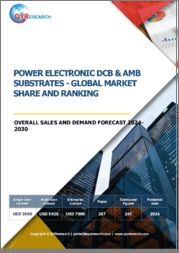
|
시장보고서
상품코드
1424964
세계 세라믹 기판 시장 : 시장 규모, 점유율 분석 : 유형별, 최종 용도별, 형상별 - 산업 수요 예측(-2030년)Ceramic Substrates Market Size and Share Analysis by Type, End Use, Form -Global Industry Revenue Estimation and Demand Forecast to 2030 |
||||||
세계 세라믹 기판 시장은 예측 기간 동안 복합 연간 성장률(CAGR) 6.3%로 성장하여 2030년에는 117억 4,080만 달러에 달할 전망입니다.
그 배경에는 나노기술과 첨단 전자 아키텍처에 대한 요구가 확대되고 있습니다. 다른 주요 촉진요인으로는 EV의 급속한발전, 태양광 발전 및 기타 재생 가능 에너지 원에 대한 관심 증가가 있습니다. 이러한 요인은 효율적인 열 관리를 위해 세라믹 기판을 필요로 하는 강력한 전자 디바이스 수요 급증으로 이어지고 있습니다.
전자 디바이스 분야는 연구 개발(R&D)의 급속한 진전에 따라 기술 혁신이 끊임없이 진행되고 있습니다. 오늘날의 장치는 복잡한 기능을 몇 초 안에 실행할 수 있게 되어, 크기도 작아지고, 중량도 수십년전과 비교해 몇 분의 1이 되고 있습니다. 이들은 모두 고급 아키텍처, 특히 집적 회로의 출현 때문입니다. 이 아키텍처는 높은 열전도성, 전기 절연성 및 기계적 지지를 필요로 하지만, 이 모든 것이 세라믹 기판으로 실현될 수 있습니다.
또한 이러한 재료는 소형화가 가능하고 작은 공간에 여러 구성 요소를 통합 할 수 있으므로 장치 성능과 기능을 향상시킵니다. 이와 같이 세라믹 기판이 칩의 형태로 사람들이 일상 생활에서 사용하는 모든 전자기기에 존재한다는 사실이 이 시장의 주요 견인 재료가 되고 있습니다.
또한, 이 업계의 기업은 경쟁력을 유지하기 위해 신제품을 개발하고 있습니다. 예를 들어 CeramTec은 2023년 5월 높은 전기 절연성, 열전도성 및 굽힘 강도를 가진 고성능 기판 Rubalit ZTA를 출시했습니다. 이 기판은 시장의 급성장 부문인 발전 및 전기 이동성에 사용할 수 있습니다.
또한 저온 동시 소성 세라믹(LTCC)은 자동차 산업 및 통신 산업에서 광범위한 목적으로 대대적으로 사용됩니다. 그 이유는 소형화와 고성능의 양립에 대한 수요가 높아지고 있기 때문입니다. 게다가 이 두 산업은 R&D(R&D)에 의해 빠르게 성장하고 있기 때문에 신기술의 도입이 가능해지고 있습니다.
게다가 자동차 업계에서는 배터리식 전기자동차(BEV)나 하이브리드 전기자동차(HEV)가 트렌드이며, 통신 분야에서는 5G 인프라·OTT·무선 디바이스가 널리 보급되고 있습니다. 세라믹 기판은 이러한 두 가지 용도에 필수적인 하이 엔드 반도체 및 전자 부품의 제조에 사용되기 때문에 이러한 요인이 시장을 강력하게 견인한다고 생각됩니다.
알루미늄 질화물: 가장 빠르게 성장하는 카테고리
제품 유형별로는 질화알루미늄(AlN)이 예측 기간 동안 6.5%로 가장 높은 복합 연간 성장률(CAGR)을 나타낼 전망입니다. 이것은 이 화합물이 세라믹 기판에 높은 내열성?내충격성?내부식성이나 우수한 열전도성을 제공하기 때문입니다. 이 때문에 고온 용도에 최적입니다. 따라서 항공 시스템, 광전자, 반도체, 전력 전자, 군사 용도, 마이크로파 통신 및 가전제품에 사용됩니다. AlN 기판은 효율적인 냉각을 가능하게 하기 위해 방열판과 칩 캐리어에도 사용됩니다.
게다가 LED 조명 산업은 알루미늄 질화물이 효율적으로 열을 관리하는 데 도움을 주며 조명 장비의 수명을 연장시켜 주요 최종 사용자가 되었습니다. 예를 들어, Nippon Carbide는 높은 휘도, 반사율, 내열성 및 방사율을 가지며 LED에 적합한 알루미늄 기반 기판의 특허를 받았습니다. 따라서 LED 조명의 사용이 상업시설·주택 분야에서 증가함에 따라 AlN 세라믹 기판 수요도 증가하고 있습니다.
이 보고서는 세계 세라믹 기판 시장을 분석하고 시장의 기본 구조, 최신 상황 및 주요 촉진 및 억제요인, 전 세계 및 지역별 및 주요 국가 시장 규모 동향 전망(수량, 금액 기준, 2017 -2030년) : 유형별?최종 용도별?형상별 상세 동향, 현재 시장 경쟁의 상황, 주요 기업프로파일 등의 정보를 전해드립니다.
목차
제1장 조사 범위
제2장 조사 방법
제3장 주요 요약
제4장 시장 지표
제5장 업계 전망
- 시장 역학
- 동향
- 성장 촉진요인
- 억제요인/과제
- 성장 촉진요인/억제요인의 영향 분석
- 신형 코로나 바이러스 감염(COVID-19)의 영향
- Porter's Five Forces 분석
제6장 시장
- 개요
- 시장 규모 : 유형별(2017-2030년)
- 시장 수익 : 유형별(2017-2030년)
- 시장 규모 : 최종 용도별(2017-2030년)
- 시장 수익 : 최종 용도별(2017-2030년)
- 시장 규모 : 형상별(2017-2030년)
- 시장 수익 : 형상별(2017-2030년)
- 시장 규모 : 지역별(2017-2030년)
- 시장 수익 : 지역별(2017-2030년)
제7장 북미 시장
- 개요
- 시장 규모 : 유형별(2017-2030년)
- 시장 수익 : 유형별(2017-2030년)
- 시장 규모 : 최종 용도별(2017-2030년)
- 시장 수익 : 최종 용도별(2017-2030년)
- 시장 규모 : 형상별(2017-2030년)
- 시장 수익 : 형상별(2017-2030년)
- 시장 규모 : 국가별(2017-2030년)
- 시장 수익 : 국가별(2017-2030년)
제8장 유럽 시장
제9장 아시아태평양 시장
제10장 라틴아메리카 시장
제11장 중동 및 아프리카(MEA) 시장
제12장 미국 시장
- 개요
- 시장 규모 : 유형별(2017-2030년)
- 시장 수익 : 유형별(2017-2030년)
- 시장 규모 : 최종 용도별(2017-2030년)
- 시장 수익 : 최종 용도별(2017-2030년)
- 시장 규모 : 형상별(2017-2030년)
- 시장 수익 : 형상별(2017-2030년)
제13장 캐나다 시장
제14장 독일 시장
제15장 프랑스 시장
제16장 영국 시장
제17장 이탈리아 시장
제18장 스페인 시장
제19장 일본 시장
제20장 중국 시장
제21장 인도 시장
제22장 호주 시장
제23장 한국 시장
제24장 브라질 시장
제25장 멕시코 시장
제26장 사우디아라비아 시장
제27장 남아프리카 시장
제28장 아랍에미리트(UAE) 시장
제29장 경쟁 구도
- 시장 진출기업과 그 제공 제품/서비스의 일람
- 주요 기업의 경쟁 벤치마킹
- 주요 기업의 제품 벤치마킹
- 최근의 전략 전개 상황
제30장 기업 프로파일
- KYOCERA Corporation
- MARUWA Co. Ltd.
- NIKKO COMPANY
- CeramTec GmbH
- KOA Corporation
- TONG HSING ELECTRONIC Industries Ltd.
- LEATEC Fine Ceramics Co. Ltd.
- Nippon Carbide Industries Co. Inc.
제31장 부록
BJH 24.02.20The global ceramic substrates market will grow at a CAGR of 6.3% in the forecast period (2024-2030) and reach USD 11,740.8 million by 2030.
This can be ascribed to the surging need for nanotechnology and advanced electronic architectures. Other key drivers are the rapid development of EVs and the rising focus on solar power and other renewable energy sources. These factors lead to a surge in the demand for powerful electronic devices, which require ceramic substrates for efficient thermal management.
The electronic device sector is continuously undergoing innovation with the robust pace of R&D. Devices today can perform complex functions in seconds, are smaller in size, and weigh a fraction of what they did a couple of decades ago. All of this is due to the emergence of advanced architectures, specifically integrated circuits. This architecture requires high thermal conductivity, electrical insulation, and mechanical support, all of which can be achieved with ceramic substrates.
These materials also enable miniaturization and increase the performance and functionalities of the devices, as they are capable of integrating multiple components in a small space. Thus, the market is primarily driven by the fact that in the chip form, ceramic substrates are present in all the electronic devices that people use in their daily lives.
Further, companies in this industry are developing new products to maintain their competitive edge. For instance, in May 2023, CeramTec launched a high-performance substrate, called Rubalit ZTA, which has high electric insulation, thermal conductivity, and flexural strength. It can used in power generation and electromobility, both of which are fast-growing market segments.
Additionally, low-temperature co-fired ceramics (LTCCs) are used extensively in the automotive and telecommunications industries for a wide range of purposes. This is because of the rising the demand for miniaturization and a high performing capability together. Further, both these industries are growing at a fast pace due to R&D, which enables the introduction of new technology.
Moreover, in the automotive industry, battery electric and hybrid electric vehicles are in trend, while in the telecommunications domain, 5G infrastructure, OTT, and wireless devices are gaining widespread popularity. These factors will strongly drive the market as
ceramic substrates are used to manufacture the high-end semiconductor and electronic components intrinsic to these two applications.
Aluminum Nitride Is Fastest-Growing Category
The aluminum nitride category in the product type segment will have the highest CAGR, of 6.5%, during the forecast period. This is because this compound offers high thermal, shock, and corrosion resistance and good thermal conductivity to the ceramic substrate. This is why it is an ideal choice for high-temperature purposes. Thus, it is used in aeronautical systems, optoelectronics, semiconductors, power electronics, military applications, and microwave communication and appliances. AlN substrates are also used in heat sinks and chip carriers as they enable efficient cooling.
Further, the LED lighting industry is a major end user because aluminum nitride helps in managing heat efficiently, which, in turn, increases the life of lighting devices. For instance, Nippon Carbide has patented an aluminum-based substrate that has high brightness, reflectivity, heat resistance, and emittance, which makes it suitable for LEDs. Therefore, as the use of LED lights is increasing in the commercial and residential sectors, the demand for AlN ceramic substrates is rising as well.
Some key players in the market are KYOCERA Corporation, MARUWA Co. Ltd., NIKKO COMPANY, CeramTec GmbH, KOA Corporation, TONG HSING ELECTRONIC Industries Ltd., LEATEC Fine Ceramics Co. Ltd., and Nippon Carbide Industries Co. Inc.
Table of Contents
Chapter 1. Research Scope
- 1.1. Research Objectives
- 1.2. Market Definition
- 1.3. Analysis Period
- 1.4. Market Size Breakdown by Segments
- 1.4.1. Market size breakdown, by type
- 1.4.2. Market size breakdown, by end use
- 1.4.3. Market size breakdown, by form
- 1.4.4. Market size breakdown, by region
- 1.4.5. Market size breakdown, by country
- 1.5. Market Data Reporting Unit
- 1.5.1. Volume
- 1.5.2. Value
- 1.6. Key Stakeholders
Chapter 2. Research Methodology
- 2.1. Secondary Research
- 2.1.1. Paid
- 2.1.2. Unpaid
- 2.1.3. P&S Intelligence database
- 2.2. Primary Research
- 2.3. Market Size Estimation
- 2.4. Data Triangulation
- 2.5. Currency Conversion Rates
- 2.6. Assumptions for the Study
- 2.7. Notes and Caveats
Chapter 3. Executive Summary
Chapter 4. Market Indicators
Chapter 5. Industry Outlook
- 5.1. Market Dynamics
- 5.1.1. Trends
- 5.1.2. Drivers
- 5.1.3. Restraints/challenges
- 5.1.4. Impact analysis of drivers/restraints
- 5.2. Impact of COVID-19
- 5.3. Porter's Five Forces Analysis
- 5.3.1. Bargaining power of buyers
- 5.3.2. Bargaining power of suppliers
- 5.3.3. Threat of new entrants
- 5.3.4. Intensity of rivalry
- 5.3.5. Threat of substitutes
Chapter 6. Global Market
- 6.1. Overview
- 6.2. Market Volume, by Type (2017-2030)
- 6.3. Market Revenue, by Type (2017-2030)
- 6.4. Market Volume, by End Use (2017-2030)
- 6.5. Market Revenue, by End Use (2017-2030)
- 6.6. Market Volume, by Form (2017-2030)
- 6.7. Market Revenue, by Form (2017-2030)
- 6.8. Market Volume, by Region (2017-2030)
- 6.9. Market Revenue, by Region (2017-2030)
Chapter 7. North America Market
- 7.1. Overview
- 7.2. Market Volume, by Type (2017-2030)
- 7.3. Market Revenue, by Type (2017-2030)
- 7.4. Market Volume, by End Use (2017-2030)
- 7.5. Market Revenue, by End Use (2017-2030)
- 7.6. Market Volume, by Form (2017-2030)
- 7.7. Market Revenue, by Form (2017-2030)
- 7.8. Market Volume, by Country (2017-2030)
- 7.9. Market Revenue, by Country (2017-2030)
Chapter 8. Europe Market
- 8.1. Overview
- 8.2. Market Volume, by Type (2017-2030)
- 8.3. Market Revenue, by Type (2017-2030)
- 8.4. Market Volume, by End Use (2017-2030)
- 8.5. Market Revenue, by End Use (2017-2030)
- 8.6. Market Volume, by Form (2017-2030)
- 8.7. Market Revenue, by Form (2017-2030)
- 8.8. Market Volume, by Country (2017-2030)
- 8.9. Market Revenue, by Country (2017-2030)
Chapter 9. APAC Market
- 9.1. Overview
- 9.2. Market Volume, by Type (2017-2030)
- 9.3. Market Revenue, by Type (2017-2030)
- 9.4. Market Volume, by End Use (2017-2030)
- 9.5. Market Revenue, by End Use (2017-2030)
- 9.6. Market Volume, by Form (2017-2030)
- 9.7. Market Revenue, by Form (2017-2030)
- 9.8. Market Volume, by Country (2017-2030)
- 9.9. Market Revenue, by Country (2017-2030)
Chapter 10. LATAM Market
- 10.1. Overview
- 10.2. Market Volume, by Type (2017-2030)
- 10.3. Market Revenue, by Type (2017-2030)
- 10.4. Market Volume, by End Use (2017-2030)
- 10.5. Market Revenue, by End Use (2017-2030)
- 10.6. Market Volume, by Form (2017-2030)
- 10.7. Market Revenue, by Form (2017-2030)
- 10.8. Market Volume, by Country (2017-2030)
- 10.9. Market Revenue, by Country (2017-2030)
Chapter 11. MEA Market
- 11.1. Overview
- 11.2. Market Volume, by Type (2017-2030)
- 11.3. Market Revenue, by Type (2017-2030)
- 11.4. Market Volume, by End Use (2017-2030)
- 11.5. Market Revenue, by End Use (2017-2030)
- 11.6. Market Volume, by Form (2017-2030)
- 11.7. Market Revenue, by Form (2017-2030)
- 11.8. Market Volume, by Country (2017-2030)
- 11.9. Market Revenue, by Country (2017-2030)
Chapter 12. U.S. Market
- 12.1. Overview
- 12.2. Market Volume, by Type (2017-2030)
- 12.3. Market Revenue, by Type (2017-2030)
- 12.4. Market Volume, by End Use (2017-2030)
- 12.5. Market Revenue, by End Use (2017-2030)
- 12.6. Market Volume, by Form (2017-2030)
- 12.7. Market Revenue, by Form (2017-2030)
Chapter 13. Canada Market
- 13.1. Overview
- 13.2. Market Volume, by Type (2017-2030)
- 13.3. Market Revenue, by Type (2017-2030)
- 13.4. Market Volume, by End Use (2017-2030)
- 13.5. Market Revenue, by End Use (2017-2030)
- 13.6. Market Volume, by Form (2017-2030)
- 13.7. Market Revenue, by Form (2017-2030)
Chapter 14. Germany Market
- 14.1. Overview
- 14.2. Market Volume, by Type (2017-2030)
- 14.3. Market Revenue, by Type (2017-2030)
- 14.4. Market Volume, by End Use (2017-2030)
- 14.5. Market Revenue, by End Use (2017-2030)
- 14.6. Market Volume, by Form (2017-2030)
- 14.7. Market Revenue, by Form (2017-2030)
Chapter 15. France Market
- 15.1. Overview
- 15.2. Market Volume, by Type (2017-2030)
- 15.3. Market Revenue, by Type (2017-2030)
- 15.4. Market Volume, by End Use (2017-2030)
- 15.5. Market Revenue, by End Use (2017-2030)
- 15.6. Market Volume, by Form (2017-2030)
- 15.7. Market Revenue, by Form (2017-2030)
Chapter 16. U.K. Market
- 16.1. Overview
- 16.2. Market Volume, by Type (2017-2030)
- 16.3. Market Revenue, by Type (2017-2030)
- 16.4. Market Volume, by End Use (2017-2030)
- 16.5. Market Revenue, by End Use (2017-2030)
- 16.6. Market Volume, by Form (2017-2030)
- 16.7. Market Revenue, by Form (2017-2030)
Chapter 17. Italy Market
- 17.1. Overview
- 17.2. Market Volume, by Type (2017-2030)
- 17.3. Market Revenue, by Type (2017-2030)
- 17.4. Market Volume, by End Use (2017-2030)
- 17.5. Market Revenue, by End Use (2017-2030)
- 17.6. Market Volume, by Form (2017-2030)
- 17.7. Market Revenue, by Form (2017-2030)
Chapter 18. Spain Market
- 18.1. Overview
- 18.2. Market Volume, by Type (2017-2030)
- 18.3. Market Revenue, by Type (2017-2030)
- 18.4. Market Volume, by End Use (2017-2030)
- 18.5. Market Revenue, by End Use (2017-2030)
- 18.6. Market Volume, by Form (2017-2030)
- 18.7. Market Revenue, by Form (2017-2030)
Chapter 19. Japan Market
- 19.1. Overview
- 19.2. Market Volume, by Type (2017-2030)
- 19.3. Market Revenue, by Type (2017-2030)
- 19.4. Market Volume, by End Use (2017-2030)
- 19.5. Market Revenue, by End Use (2017-2030)
- 19.6. Market Volume, by Form (2017-2030)
- 19.7. Market Revenue, by Form (2017-2030)
Chapter 20. China Market
- 20.1. Overview
- 20.2. Market Volume, by Type (2017-2030)
- 20.3. Market Revenue, by Type (2017-2030)
- 20.4. Market Volume, by End Use (2017-2030)
- 20.5. Market Revenue, by End Use (2017-2030)
- 20.6. Market Volume, by Form (2017-2030)
- 20.7. Market Revenue, by Form (2017-2030)
Chapter 21. India Market
- 21.1. Overview
- 21.2. Market Volume, by Type (2017-2030)
- 21.3. Market Revenue, by Type (2017-2030)
- 21.4. Market Volume, by End Use (2017-2030)
- 21.5. Market Revenue, by End Use (2017-2030)
- 21.6. Market Volume, by Form (2017-2030)
- 21.7. Market Revenue, by Form (2017-2030)
Chapter 22. Australia Market
- 22.1. Overview
- 22.2. Market Volume, by Type (2017-2030)
- 22.3. Market Revenue, by Type (2017-2030)
- 22.4. Market Volume, by End Use (2017-2030)
- 22.5. Market Revenue, by End Use (2017-2030)
- 22.6. Market Volume, by Form (2017-2030)
- 22.7. Market Revenue, by Form (2017-2030)
Chapter 23. South Korea Market
- 23.1. Overview
- 23.2. Market Volume, by Type (2017-2030)
- 23.3. Market Revenue, by Type (2017-2030)
- 23.4. Market Volume, by End Use (2017-2030)
- 23.5. Market Revenue, by End Use (2017-2030)
- 23.6. Market Volume, by Form (2017-2030)
- 23.7. Market Revenue, by Form (2017-2030)
Chapter 24. Brazil Market
- 24.1. Overview
- 24.2. Market Volume, by Type (2017-2030)
- 24.3. Market Revenue, by Type (2017-2030)
- 24.4. Market Volume, by End Use (2017-2030)
- 24.5. Market Revenue, by End Use (2017-2030)
- 24.6. Market Volume, by Form (2017-2030)
- 24.7. Market Revenue, by Form (2017-2030)
Chapter 25. Mexico Market
- 25.1. Overview
- 25.2. Market Volume, by Type (2017-2030)
- 25.3. Market Revenue, by Type (2017-2030)
- 25.4. Market Volume, by End Use (2017-2030)
- 25.5. Market Revenue, by End Use (2017-2030)
- 25.6. Market Volume, by Form (2017-2030)
- 25.7. Market Revenue, by Form (2017-2030)
Chapter 26. Saudi Arabia Market
- 26.1. Overview
- 26.2. Market Volume, by Type (2017-2030)
- 26.3. Market Revenue, by Type (2017-2030)
- 26.4. Market Volume, by End Use (2017-2030)
- 26.5. Market Revenue, by End Use (2017-2030)
- 26.6. Market Volume, by Form (2017-2030)
- 26.7. Market Revenue, by Form (2017-2030)
Chapter 27. South Africa Market
- 27.1. Overview
- 27.2. Market Volume, by Type (2017-2030)
- 27.3. Market Revenue, by Type (2017-2030)
- 27.4. Market Volume, by End Use (2017-2030)
- 27.5. Market Revenue, by End Use (2017-2030)
- 27.6. Market Volume, by Form (2017-2030)
- 27.7. Market Revenue, by Form (2017-2030)
Chapter 28. U.A.E. Market
- 28.1. Overview
- 28.2. Market Volume, by Type (2017-2030)
- 28.3. Market Revenue, by Type (2017-2030)
- 28.4. Market Volume, by End Use (2017-2030)
- 28.5. Market Revenue, by End Use (2017-2030)
- 28.6. Market Volume, by Form (2017-2030)
- 28.7. Market Revenue, by Form (2017-2030)
Chapter 29. Competitive Landscape
- 29.1. List of Market Players and their Offerings
- 29.2. Competitive Benchmarking of Key Players
- 29.3. Product Benchmarking of Key Players
- 29.4. Recent Strategic Developments
Chapter 30. Company Profiles
- 30.1. KYOCERA Corporation
- 30.1.1. Business overview
- 30.1.2. Product and service offerings
- 30.1.3. Key financial summary
- 30.2. MARUWA Co. Ltd.
- 30.2.1. Business overview
- 30.2.2. Product and service offerings
- 30.2.3. Key financial summary
- 30.3. NIKKO COMPANY
- 30.3.1. Business overview
- 30.3.2. Product and service offerings
- 30.3.3. Key financial summary
- 30.4. CeramTec GmbH
- 30.4.1. Business overview
- 30.4.2. Product and service offerings
- 30.4.3. Key financial summary
- 30.5. KOA Corporation
- 30.5.1. Business overview
- 30.5.2. Product and service offerings
- 30.5.3. Key financial summary
- 30.6. TONG HSING ELECTRONIC Industries Ltd.
- 30.6.1. Business overview
- 30.6.2. Product and service offerings
- 30.6.3. Key financial summary
- 30.7. LEATEC Fine Ceramics Co. Ltd.
- 30.7.1. Business overview
- 30.7.2. Product and service offerings
- 30.7.3. Key financial summary
- 30.8. Nippon Carbide Industries Co. Inc.
- 30.8.1. Business overview
- 30.8.2. Product and service offerings
- 30.8.3. Key financial summary
Chapter 31. Appendix
- 31.1. Abbreviations
- 31.2. Sources and References
- 31.3. Related Reports



















